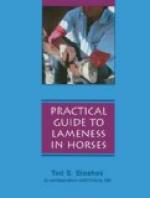The use of the actual cautery when properly employed constitutes an excellent method of treatment. The “auto-cautery” when equipped with a point of about one-eighth of an inch in diameter and about three-fourths of an inch in length is well suited for this particular operation. Before deciding to cauterize, it is necessary to ascertain the extent of area affected. The nearness of the exostosis to the tibiotarsal articulation can be definitely determined by palpation. The hair over the entire surgical field is clipped and the cautery at white heat is pushed through the overlying soft tissues and into the central part of the exostosis. Care is taken to keep the cautery-point away from the articular margin of the tibial tarsal bone about three-fourths of an inch. No danger will result from cauterizing to a depth of three-fourths of an inch in the average case. Two or three (and not more) centrally located points for penetration with the cautery are sufficient. Experience has shown that several (five or six or more) punctures are not productive of good results. When considerable cicatricial tissue is present, due to the action of depilating vesicants or other chemicals, sloughing of tissue is very apt to follow deep cauterization, if one is not careful to keep the punctures at least one-half inch apart when three are made. It is best, in such cases, to make but two deep penetrations with the cautery but additional superficial punctures may be made if kept about three-fourths of an inch distant and not nearer than this to one another. Sloughing of tissue is not necessarily productive of bad results but there is occasioned an open wound which usually becomes infected and necrosis of tissue may extend into the articulation. No benefit results from sloughing and it should be avoided. In small horses, one deep point of cauterization is sufficient if the osseous tissues are penetrated to a proper depth so that an active inflammation is induced. The cautery may, if necessary, be reintroduced several times. When the field of operation has been properly prepared and it is thought advisable (as where subjects are kept in the hospital for a time), the hock may be covered with cotton and bandaged and no chance for infection will occur.
After cauterization the subject should be kept quiet in a comfortable stall for three weeks; thereafter, if the animal is not too playful, the run of a paddock may be allowed for about ten days and a protracted rest of a month or more at pasture is best. It is unwise in the average case to put an animal in service earlier than two months after having been “fired.”




